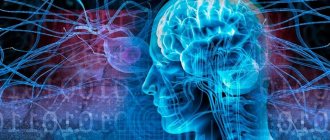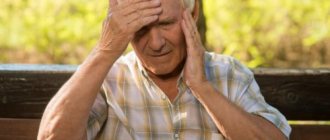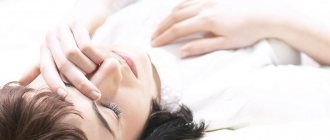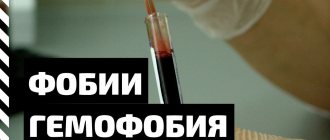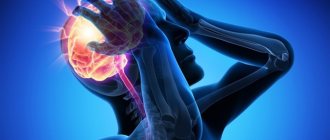Risk factors for strokes
- Diseases of the cardiovascular system: atrial fibrillation, heart failure, hypertension, arrhythmia, tendency to form blood clots, etc.
- Regular stress, chronic fatigue, overexertion.
- Age over 45 years for men and over 50 years for women.
- Migraine.
- Alcohol abuse, drug addiction, smoking.
- Metabolic disease.
- Diabetes.
- Excess body weight, sedentary lifestyle, unhealthy diet: eating fatty, spicy, fried, smoked foods.
- Long-term (more than 5 years) use of hormonal drugs.
- Heredity.
- Infectious and inflammatory processes (systemic lupus erythematosus, etc.).
- Gender: The risk of stroke is higher in men than in women.
These factors lead to a decrease in the elasticity of blood vessels, increased load on them, the formation of atherosclerotic plaques, and an increase in the amount of sugar and bad cholesterol in the blood.
Patients at risk should regularly check their health with a doctor, undergo a CT scan or MRI of the brain, conduct a study of the cerebral cortex, take a blood test for sugar and cholesterol levels, blood clotting, etc.
To understand what measures to take to prevent stroke, you need to know the main risk factors for the development of this pathology. Of particular interest are the modifiable ones, since in most cases they can be eliminated.
RISK FACTORS
- age (there are many more patients over 60 years old than younger ones);
- high blood pressure (the risk increases in proportion to blood pressure);
- heart disease , for example, with a permanent form of atrial fibrillation, the incidence of ischemic stroke increases sharply;
- diabetes mellitus , since metabolic disorders lead to the development of atherosclerosis;
- Smoking increases the risk of death from acute cerebral circulatory disorders by more than 50%.
- taking certain medications (oral contraceptives, anticoagulants).
Primary prevention of stroke is based on preventing the occurrence of risk factors for the disease, both individually and nationally.
Secondary prevention of stroke involves eliminating risk factors that, when certain conditions are combined, can lead to relapse of the disease. In this case, the most effective method is regular clinical observation, which allows you to timely identify various abnormalities and begin their treatment.
To prevent stroke, it is important to carry out timely treatment of diseases that can lead to its development.
Primary and secondary prevention of stroke can be carried out both with the use of medications and by avoiding harmful exposure factors.
NON-DRUG PREVENTION
REJECTION OF BAD HABITS
— Smoking significantly increases the risk of blood clots and the development of cerebral atherosclerosis. Therefore, completely giving up this bad habit can reduce the likelihood of cerebrovascular accidents and improve the quality and life expectancy of patients after a stroke. It is worth noting that reducing the number of cigarettes smoked per day has virtually no effect on the likelihood of an ischemic attack.
- Alcohol , on the contrary, in moderate quantities prevents the deposition of cholesterol in the walls of blood vessels, but when consumed in excess, blood pressure and heart rate increase. Consequently, the risk of intracerebral hemorrhage increases.
DIET
The diet used to prevent cerebrovascular accidents should contain large amounts of fruits, fish and vegetables. You should reduce the consumption of foods containing cholesterol, preservatives and easily digestible carbohydrates. It is also necessary to strive to reduce excess body weight. It is very important to avoid sudden jumps and lose weight gradually. In your diet to prevent stroke, you should increase the amount of vegetables, fiber and fruits.
MODERATE PHYSICAL ACTIVITY
Daily physical activity helps the body cope with obesity and stress, and also makes blood vessels more resistant to external influences. The risk of sudden death is reduced by a third. It is worth remembering that the loads should not be too intense and be sure to perform the exercises regularly. Otherwise, there will be no effect, and it can only cause harm to a weakened body.
DRUG PREVENTION
Medicines are mainly used for secondary prevention of acute cerebrovascular accident. In some cases, after a transient ischemic attack, reconstructive operations on the carotid arteries are performed, which also significantly reduce the risk of stroke.
BLOOD PRESSURE CONTROL
All patients with hypertension need to monitor their blood pressure numbers and try to maintain them no higher than 140/90 mmHg. To do this, you should measure blood pressure twice a day, and it is also advisable to keep a special diary. The cardiologist must select the optimal therapy, and in urgent cases, for example, during a hypertensive crisis, additional short-acting drugs (Capoten, Corinfar) can be used. This method is effective for the prevention of both ischemic and hemorrhagic stroke, because as a result of prolonged arterial hypertension, restructuring of the arterial wall occurs, in which microaneurysms can form.
TAKING DISAGGREGANTS
Prevention of ischemic stroke necessarily includes taking antiplatelet agents (aspirin). This medicine affects the blood coagulation system and prevents the formation of blood clots, which most often lead to the final narrowing of the artery lumen. According to studies, daily intake of aspirin at a dose of 75-125 mg reduces the risk of recurrent stroke by at least a quarter.
HYPOLYPIDEMIC THERAPY
Since atherosclerosis is one of the main risk factors for the development of cerebrovascular accidents, treatment of this disease is a method of preventing stroke. Taking medications (statins) and selecting their dose must be carried out under the control of the blood lipid profile and must be combined with a special diet. It is worth noting that these drugs should be taken for life.
Primary prevention
About 80% of all strokes are primary. Basic preventive measures:
- Lifestyle changes. The patient must give up bad habits and a sedentary lifestyle, and start eating right. The diet should consist mainly of steamed, boiled and stewed dishes, low-fat dairy products, and fish. Be sure to drink about 8 glasses of water. Physical training should be age-appropriate; sometimes it is enough to add walking. Diet and moderate exercise will help normalize weight and improve health. It is equally important to eliminate or minimize stress, overexertion, and sleep 8 hours a day.
- Blood pressure control. Normal values are 120-140 mmHg. Art. for the upper and no more than 80-90 mm Hg. Art. for the bottom. The change must be made at the same time every day. If your readings increase, you should consult a doctor, he will select treatment and prescribe medications to stabilize your blood pressure.
- Controlling blood sugar and bad cholesterol levels.
- Taking medications , such as antithrombotic drugs.
Secondary prevention
The main task of secondary prevention is to reduce the likelihood of developing a recurrent stroke to a minimum. Basic measures:
- Regular monitoring of blood pressure and reducing it to normal levels if necessary.
- Changing your diet: it is important to reduce the amount of salt consumed, eat more vegetables and fruits, low-fat dairy products, eliminate fatty, fried and smoked foods, and alcohol.
- Normalize weight, exercise for at least half an hour every two days.
- Drug therapy especially for patients with signs of atherosclerosis and patients who have experienced ischemic stroke or transient ischemic attacks. Medicines help lower cholesterol and blood pressure, cope with inflammatory diseases and exacerbations of chronic diseases.
- Regular visits to a neurologist. The doctor can monitor changes in the patient’s condition, adjust therapy, prescribe medications or procedures, and give recommendations regarding hospitalization.
Stroke: was it or wasn’t it?
However, as strange as it may sound, there are people with a repeated risk of stroke who are not even aware of the previous vascular accident they suffered!
We are talking about transient ischemic attacks and so-called “silent” strokes. In the first case, typical manifestations of a stroke disappear in less than a day, and sometimes even hours/minutes. In the second, and this is more typical for older people, the symptoms of a stroke do not appear at all, have a blurred picture, or the condition quickly normalizes. Typical manifestations of acute transient cerebrovascular accident include: transient loss of vision, temporary disturbance or loss of speech, transient weakness in the arm and/or leg, sudden memory loss and/or disorientation, temporary loss of sensation in the arm and/or leg (usually on one side of the body). In such a situation, there is only one option: you need to immediately consult a doctor, preferably a neurologist.
Prevention of ischemic stroke
Measures to prevent ischemic stroke, in addition to those listed above, include drug therapy. All medications must be prescribed by a doctor. Typically these medications are:
- preventing the formation of blood clots;
- lowering cholesterol levels;
- increasing the tone of blood vessels and strengthening their walls;
- activating metabolism in the brain;
- having a calming effect.
If you or your family have experienced a stroke, take care of your health and contact. Rehabilitation after a stroke will allow you to recover and reduce the risk of developing a recurrent vascular accident.
Stroke: to be or not to be?
Neurologists dealing with acute cerebrovascular accidents have always had, are, and most likely will continue to face two main tasks for a long time:
- treatment of a patient in the acute period of stroke;
- secondary prevention of ischemic stroke.
What is the treatment of a patient in the acute period of a stroke is quite clear. An acute cerebrovascular accident (stroke, stroke) has occurred, and the doctors’ task is to save the patient’s life and ensure that the consequences of the stroke are as minimal as possible.
What does the phrase “secondary prevention” mean? Secondary prevention of stroke is the search for, treatment and minimization of the manifestations of the diseases that led to the stroke. That is, this is all that patients and their relatives mean when they say “we were treated for a stroke,” and show the doctor an extract from the hospital, which lists drugs “for the heart,” “for blood pressure,” “for thinning the blood,” “for cholesterol.” etc.
Among diseases leading to death or severe disability, stroke confidently remains in the group of leaders. Statistics show that, having experienced the first stroke (even one that did not lead to deep disability), a person without proper care, treatment, and prevention will most likely live no more than 8-9 years. If, under all these conditions, a second stroke occurs, and it is also possible to survive it, then about 2-3 years have already been released.
And experts have no doubt that without proper prevention, the patient’s death will occur very soon (whether from a recurrent stroke, another cardiovascular disease, or from complications caused by limitation of life activity).
Again, according to statistics, if a patient has suffered one stroke, then within a year with a probability close to 15% he will “get” a second one. This probability increases exponentially with untreated background and concomitant diseases, and after a few years the threat of death is already approaching 30-40%.
The thing is that a stroke is not only often the result of decompensation of any associated diseases, but also provokes the development of new or decompensation of manifestations of existing diseases.
So, having experienced an acute cerebrovascular accident, a person adds a bunch of new ones to the already existing “bouquet” of diseases (to which he did not pay due attention - otherwise how would a stroke have occurred?). And this is against the background of a condition already weakened by a serious illness.
Secondary prevention is the only way to reduce the risk of recurrent stroke, reduce the risks of decompensation of old and the emergence of new diseases associated with a stroke.
